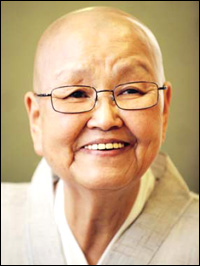
|
|
|
Home Asia Pacific North Asia S/N Korea Arts & Culture 'Bhikkhunis' Hold Unique Place in BuddhismBy Ines Min, The Korea Times, Oct 8, 2009Seoul, South Korea -- Imagine having to live your life strictly adhering to 348 precepts - think you're up to the challenge?
In daily life, bhikkhunis, or Buddhist nuns, abide by nearly 100 more regulations than monks, who follow roughly 250 laws. Women who practice the religion are subjected to different laws at times, but Korea may be one of the more accepting countries for Buddhist females to live. Bhikkhunis have been around since the time of Buddha, but the number of ordained Buddist nuns has been growing over the past few decades, sparking an ever-growing number of controversies. Different sects of Buddhism have come to either support or outlaw Buddhist nuns. Korea, Vietnam, China and Taiwan are a few of the countries where those in training can receive ordination. In Thailand, where roughly 95 percent of the population is Buddhist, male bhikkhus do not believe it appropriate for women to serve an active role in monastery life. Sri Lanka showed a similar hesitation toward the increasing population of bhikkhunis, which resulted in 10 women flying to Sarnath, India, in 1996 to be ordained by Korean bhikkhunis. Although discrimination can be found in nearly all countries, the head bhikkhuni at Bongnyeongsa Temple, a Suwon branch of the Jogye Order in South Korea, said such extreme cases of prejudice is rarely found here.
Physical differences in women's bodies are equalized by the more technical matters of Buddhism, such as garments and the number of precepts. Traditionally, a monk wears three articles of clothing, minimizing the hassle, distraction and costs from his outfit. However, bhikkhunis must don five pieces of clothing, including a vest that is worn tightly to press down her breasts. ``A woman's body is more complex than a man's,'' Ven. Myoeom said. ``But there's nothing we can't do as women.'' Other gender-specific laws found in Buddhism to compensate for the physical differences involve the number of levels taken to complete ordination. While monks only have two steps, nuns must take a total of three to be ordained, according to the Buddha Dharma Education Association's Web site. The final step is a training period of two years, in which the applicant must not transgress any of the precepts in order to pass. ``There was a particular case of a married woman who asked for ordination without knowing that she had conceived,'' according to the Web site. ``Her pregnancy came to light only after ordination. Hence a rule was laid down and women have to go through Sikkhamana training for two years.'' A nun from the Jogye Order of Korean Buddhism organization agreed that South Korea has not shown much discrimination against bhikkhunis. In fact, it's been nearly 400 years since the first bhikkhuni in Korea, so it's not necessarily a new phenomenon. "Although many wouldn't believe so, women can do everything men do,'' Ven. Myoeom said. "We do it with wisdom, which is more powerful.'' Who is Ven. Myoeom? Ven. Myoeom was 14 years old when she first left home to seek refuge in a Buddhist temple during the Japanese occupation in the 1930s. She was sent by her father to hide from the plight of comfort women and eventually began training during her stay. Ven. Myoeom soon came to train under the Ven. Seongcheol, one of the legendary Jogye Order masters. She later became the first bhikkhuni to be ordained by the renowned monk. She received an opportunity to teach in a university in 1956. She moved to Bongnyeongsa Temple, Suwon, in 1971, and became the chief nun and president of the school there eight years later. Ven. Myoeom helped transform the school into a university which now teaches a range of nuns. She currently resides at Bongnyeongsa Temple where she headed the organization of the 2009 Temple Food Festival. She has been called by some the ``Godmother of Buddhist Nuns'' in Korea. |
 |
|
| Korean Buddhist News from BTN (Korean Language) |
|
 |
|
|
Please help keep the Buddhist Channel going |
|
| Point
your feed reader to this location |
|

 << Ven. Myoeom
<< Ven. Myoeom

